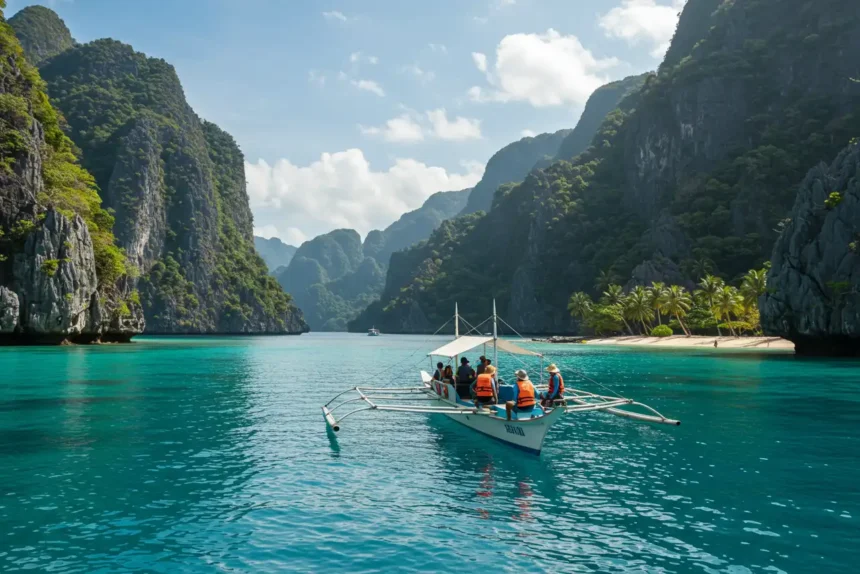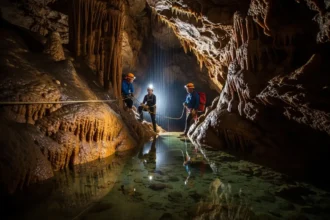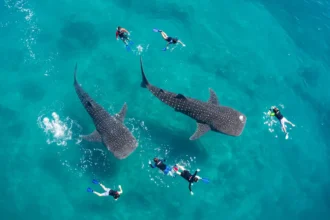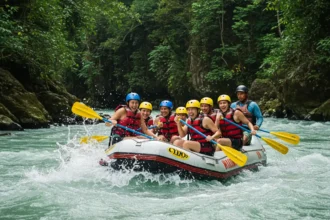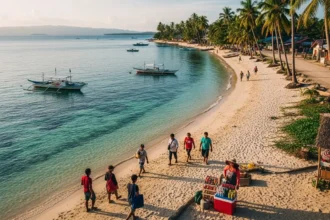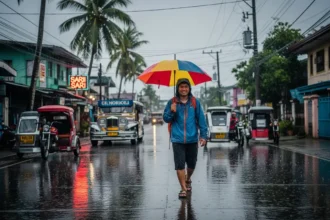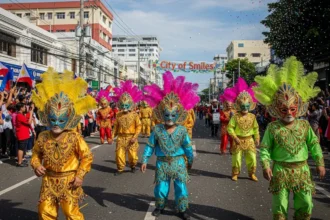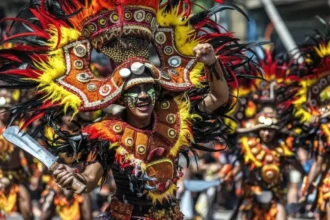There’s a moment in El Nido when you just stop paddling – and it hits you. The water’s so clear you can see the sand ripple beneath, the limestone cliffs rise like cathedral walls, and the wind smells faintly of salt and adventure. You look around and think, “Grabe, ang ganda ng Pilipinas.”
- 🚤 How El Nido Island Hopping Works
- 🩵 Tour A – The Classic Lagoon & Beach Adventure
- 🪸 Tour B – Caves, Islands, and Hidden Gems
- 🧭 Tour C – Secret Beaches and Snorkeling Spots
- 🌺 Tour D – The Laid-Back Cadlao Experience
- 🧭 How to Choose Between Tour A, B, C, and D (Which One’s for You)
- 🎒 What to Bring for Your El Nido Island Hopping Tour
- 🌤️ Best Time to Visit El Nido (Weather, Season, and Crowd Tips)
- 🚐 How to Get to El Nido and Where to Stay
- 💸 Budget Breakdown and Travel Tips for El Nido Island Hopping
- ❓ FAQs About El Nido Island Hopping
- 🌞 The Kind of Beauty That Stays With You
- 🧭 References
This is what El Nido island hopping is all about – pure wonder, no filters. Whether you’re chasing secret lagoons, swimming through turquoise coves, or eating grilled fish on a tiny sandbar, this place feels unreal in the best way.
But here’s the thing – El Nido isn’t just one island or one tour. It’s a whole archipelago of adventures, divided into four main island-hopping routes: Tour A, B, C, and D. Each one has its own vibe – from the postcard-famous lagoons of Miniloc to the quiet, hidden beaches tourists often skip.
So before you grab that life vest and waterproof pouch, let’s break it all down – how to choose the right tour, what to expect, and how to do it the Pinoy way (tipid pero sulit).
Because in El Nido, every island feels like the main event – and every wave has a story to tell. 🌊
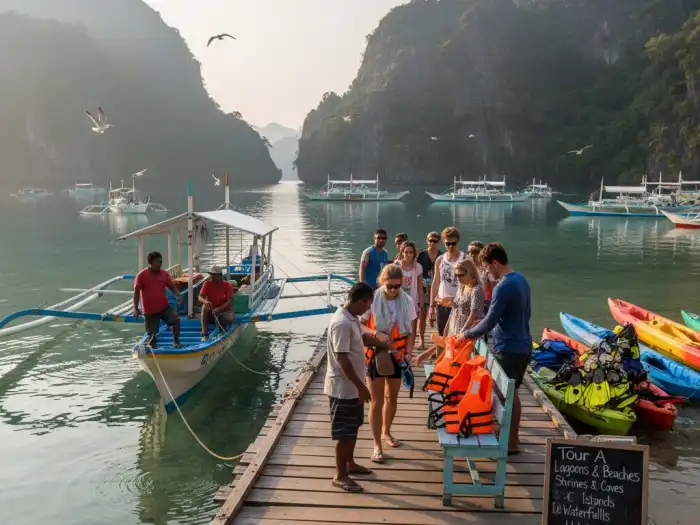
🚤 How El Nido Island Hopping Works
If there’s one thing you can’t skip in El Nido, it’s island hopping. It’s the main attraction – the reason people fly all the way to northern Palawan. But before you dive into those turquoise waters, here’s how it actually works.
🗺️ The Basics
El Nido island hopping is divided into four tour packages – A, B, C, and D. Each one covers a cluster of islands and lagoons within Bacuit Bay, just a short boat ride from town.
-
Tour A – Lagoons and beaches (the most famous one)
-
Tour B – Caves and hidden coves
-
Tour C – Secret beaches and snorkeling spots
-
Tour D – Chill and less crowded islands near Cadlao
All tours are organized by licensed operators under the El Nido Protected Area Management Board (PAMB). You can book through your hotel, a local travel agency, or walk along the beachfront where dozens of legit operators line up every morning.
💸 Standardized Rates (as of 2025)
| Tour Type | Price (₱) | Inclusions |
|---|---|---|
| Tour A | 1,200–1,400 | Lagoon access, lunch, snorkeling gear |
| Tour B | 1,300–1,500 | Caves, coves, lunch, guide |
| Tour C | 1,400–1,600 | Secret beaches, snorkeling, lunch |
| Tour D | 1,000–1,200 | Cadlao area, beach hopping, lunch |
| Eco-Tourism Fee | 200 | One-time payment valid for 10 days |
Each tour runs from 9 AM to around 4 PM, with multiple stops. Group tours use shared motorized boats (around 12–16 pax), but you can also rent private boats if you want full flexibility – great for families or couples who want to skip the crowd.
⚓ Local Hack
If you’ve got two or three days in El Nido, go for Tour A and Tour C first. They’re the best combo – lagoons + secret beaches = chef’s kiss. You can save Tour D for a chill last day before heading back to Puerto Princesa.
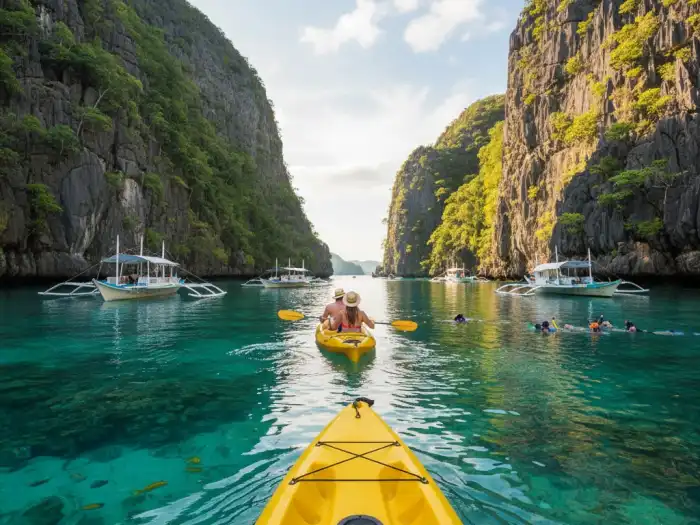
🩵 Tour A – The Classic Lagoon & Beach Adventure
If you only have time for one island-hopping tour, make it Tour A. This is El Nido’s superstar – the one you see on postcards, travel vlogs, and even foreign documentaries. It’s the full “wow, I can’t believe this is real” experience.
🛶 Main Stops on Tour A
| Spot | Highlight | Vibe |
|---|---|---|
| Small Lagoon | Kayak through emerald waters surrounded by limestone cliffs | Serene, magical |
| Big Lagoon | Vast blue expanse perfect for photos and drone shots | Grand, cinematic |
| Secret Lagoon | Hidden behind a rock hole you have to squeeze through | Mysterious, fun |
| Shimizu Island | Snorkeling area + grilled lunch stop | Relaxed, social |
| Seven Commandos Beach | Final stop with white sand and beach bars | Chill, tropical |
The tour usually starts with Small Lagoon or Big Lagoon, depending on tide schedules and crowd control. Kayak rentals (₱250–₱300) are available at the lagoons – worth every peso for that peaceful paddle surrounded by cliffs taller than buildings.
🧂 The Local Flavor
Lunch is usually served Pinoy-style on the beach – grilled fish, pork, ensalada, and rice on banana leaves. You’ll eat barefoot, salty, and sun-kissed, with the sound of gentle waves as background music. If that’s not paradise, I don’t know what is.
🌊 Traveler’s Move
Bring your own dry bag and GoPro. There’s no avoiding the splash zone, and trust me – you’ll want to capture that moment when your kayak glides through the lagoon entrance. Also, wear reef-safe sunscreen; we keep El Nido’s waters clean and thriving that way.
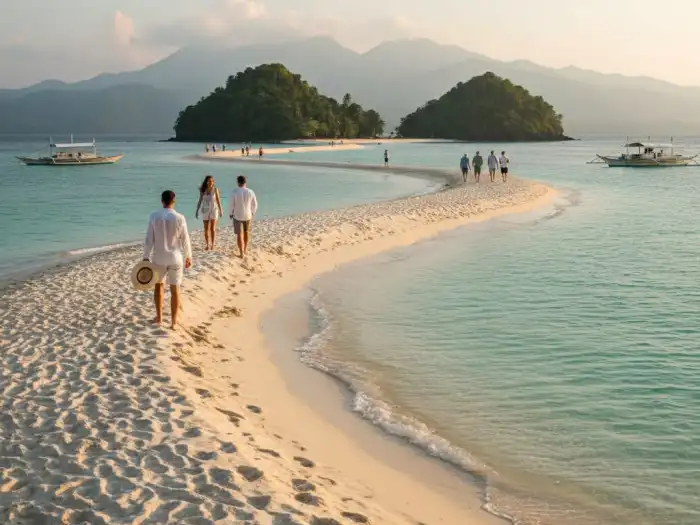
🪸 Tour B – Caves, Islands, and Hidden Gems
Tour B doesn’t get as much hype as A or C, but that’s exactly why it’s special. It’s quieter, more mysterious, and perfect if you like exploring without elbowing through crowds. Here, it’s less about the postcard spots and more about the feeling – discovering corners of El Nido that most tourists skip.
🌊 Main Stops on Tour B
| Spot | Highlight | Vibe |
|---|---|---|
| Snake Island | A natural sandbar shaped like a snake – walk from island to island at low tide | Chill, unique |
| Cudugnon Cave | Crawl through a narrow opening into a cathedral-like cave once used by ancient locals | Historical, cool |
| Cathedral Cave | Huge rock formation viewable from the boat – shaped like a church interior | Majestic, eerie |
| Pinagbuyutan Island | Palm-lined beach with epic views of limestone cliffs | Relaxed, photogenic |
| Entalula Island | White sand and turquoise water, ideal for swimming | Idyllic, private-feel |
🧭 What to Expect
Tour B has that “explorer” vibe – think Indiana Jones meets tropical chill. You’ll climb through caves, duck under low rock ceilings, then suddenly emerge into bright white sand and clear blue water. Most boats serve lunch on Pinagbuyutan Island, one of the prettiest beaches in Bacuit Bay (seriously, it’s wallpaper material).
Because it’s less crowded, it’s also more peaceful. You’ll hear waves echo inside the caves, see swallows dart across the cliffs, and sometimes have entire islands to yourself.
🌴 Traveler’s Move
Bring aqua shoes – the caves have sharp rocks, and the sandbars can get hot by noon. Tour B also has some of the best aerial views, so if you’ve got a drone, this is the day to use it. Just ask your guide which areas allow flying.
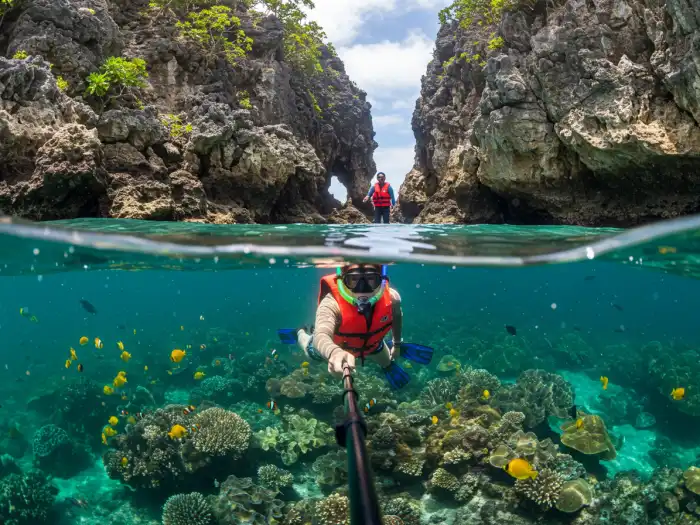
🧭 Tour C – Secret Beaches and Snorkeling Spots
Tour C is for the bold ones – the kind who don’t mind a little swimming, a little climbing, and a lot of jaw-dropping scenery. It’s the most adventurous among all El Nido tours, mixing secret beaches, coral gardens, and rugged island vibes that feel straight out of a dream.
🏝️ Main Stops on Tour C
| Spot | Highlight | Vibe |
|---|---|---|
| Hidden Beach | Reachable only by swimming through a small rock opening | Adventurous, quiet |
| Matinloc Shrine | Abandoned religious site with epic cliff views | Mystical, scenic |
| Secret Beach | Swim through a crack in the limestone to find a hidden lagoon | Magical, isolated |
| Tapiutan Island | Snorkeling haven with coral reefs and marine life | Vibrant, colorful |
| Helicopter Island (Dilumacad) | Long beach shaped like a helicopter tail | Iconic, dramatic |
🌊 Why Everyone Loves Tour C
There’s a reason most travelers argue whether Tour A or C is better – Tour C has that raw, wild feel. It’s less polished, more unpredictable, and every stop feels like a reward for effort. Swimming through that narrow entrance to Secret Beach? Goosebumps. The moment you pop your head out inside a hidden lagoon surrounded by cliffs? Pure magic.
Lunch is usually served on Tapiutan Island, with tables set right on the sand – grilled seafood, fruits, rice, the works. By this point, you’ll be sunburned, salty, and smiling.
🐠 Traveler’s Move
Don’t skip snorkeling here. Bring your own mask or snorkel if you have one – rental ones can be foggy or loose. And if you’re prone to motion sickness, pop a Bonamine before boarding; Tour C covers more open-sea stretches than the others.
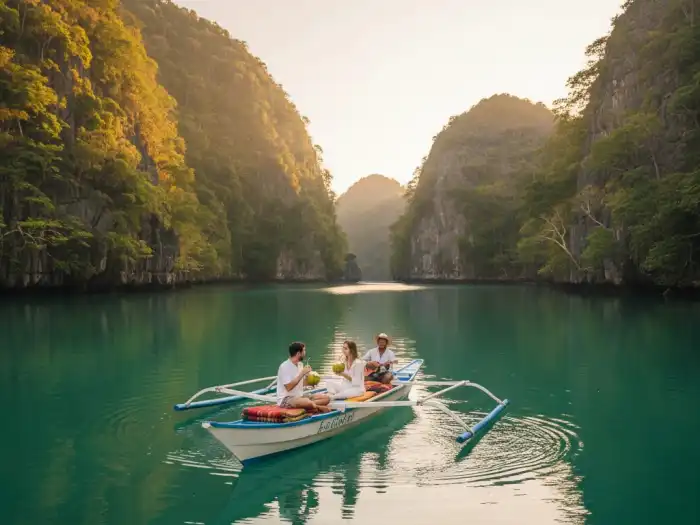
🌺 Tour D – The Laid-Back Cadlao Experience
After the drama of lagoons and secret beaches, Tour D is like a deep breath. It’s slower, quieter, and perfect for travelers who just want to float, swim, and soak up the island life without the rush. Most stops are around Cadlao Island, the large, green mountain you see right across El Nido town.
🏖️ Main Stops on Tour D
| Spot | Highlight | Vibe |
|---|---|---|
| Paradise Beach | Shallow waters, powdery sand, no crowd | Peaceful, private |
| Pasandigan Beach | Palm-lined cove with small huts for resting | Chill, cozy |
| Cadlao Lagoon | Smaller version of Big Lagoon, great for kayaking | Calm, scenic |
| Nat Nat Beach | Good swimming spot near Cadlao Island | Simple, local |
| Bukal Beach | Underrated, clean, perfect for a quiet picnic | Undiscovered, romantic |
🌴 Why Tour D Is Worth It
Tour D often gets overlooked – and that’s what makes it a hidden gem. You’ll spend more time swimming, snorkeling, or just lying on the sand while your boatman grills lunch nearby. The waters here are calm and shallow, making it great for families or first-time island hoppers.
It’s also closer to the mainland, so you spend less time on the boat and more time actually enjoying the islands. Some travelers even rent kayaks to explore Cadlao independently if the weather’s calm.
🐚 Traveler’s Move
If you’ve already done Tours A and C, save Tour D for your last day. It’s the perfect way to unwind before flying home – slow, sunny, and peaceful. Bring snacks or beer from town; most stops don’t have vendors.
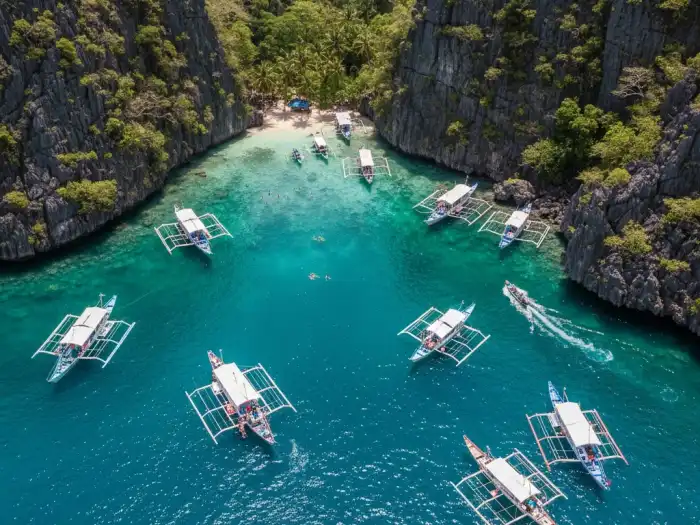
🧭 How to Choose Between Tour A, B, C, and D (Which One’s for You)
You’ve seen the posters, talked to tour agents, and everyone says the same thing – “Lahat maganda!” Which is true, but each El Nido tour has its own flavor. The best one for you depends on what kind of traveler you are (and how much you love getting sunburned).
🩵 Tour A – For the First-Timers and Lagoon Lovers
If it’s your first time in El Nido, start with this. Tour A gives you the iconic lagoon experience – Small Lagoon, Big Lagoon, Secret Lagoon – basically everything you’ve seen on travel vlogs. It’s easy, stunning, and picture-perfect.
🪸 Tour B – For the Curious Explorer
More caves, fewer crowds. Tour B is ideal if you want that sense of discovery – crawling through rock openings, walking sandbars, exploring hidden chambers. Slightly underrated, but deeply satisfying.
🏝️ Tour C – For the Adventurous and Active
The best mix of challenge and beauty. You’ll swim through tight rock gaps, explore secret beaches, and snorkel in coral gardens. Tour C has the strongest “wow” factor – but it also demands energy and confidence in the water.
🌺 Tour D – For the Chill Soul
You’ve done the adventures, now it’s time to relax. Tour D is slow-paced, peaceful, and close to town. Perfect for those who just want to float, nap on the sand, and take photos without rushing.
| Tour Type | Best For | Highlights |
|---|---|---|
| Tour A | First-timers | Lagoons, beaches, kayaking |
| Tour B | Explorers | Caves, sandbars, quiet spots |
| Tour C | Adventurers | Secret beaches, snorkeling |
| Tour D | Relaxed travelers | Calm lagoons, near Cadlao |
🌞 Traveler’s Move
If you’ve got 2–3 days in El Nido, go with Tour A and Tour C – the dream combo. Do A first (warm-up), then C for the adventure finale. Add D if you have a lazy extra day before heading back to Puerto Princesa.
🎒 What to Bring for Your El Nido Island Hopping Tour
El Nido might look glamorous on Instagram, but once you’re out on the boat – it’s all salt, sun, and splash. The trick is to pack light but smart. You’ll be wet most of the day, so comfort and waterproofing are key.
🧢 Essentials You Shouldn’t Forget
| Item | Why It Matters |
|---|---|
| Dry Bag (10L–20L) | Keeps your phone, wallet, and camera safe from splashes |
| Waterproof Phone Pouch | You will want to take photos mid-paddle |
| Extra Clothes + Towel | You’ll be soaked after the first stop |
| Sunscreen (reef-safe) | Protects your skin and the coral reefs |
| Reusable Water Bottle | Bring your own – less plastic waste, more hydration |
| Snorkel/Mask | Rentals are fine, but your own fits better |
| Flip-flops / Aqua Shoes | Some stops have rocky or hot sand areas |
| Power Bank | You’ll drain your battery taking photos all day |
| Hat / Rash Guard | The Palawan sun is no joke |
| Cash (Small Bills) | For kayak rentals, tips, and small snacks |
🌊 Local Hack
Buy reef-safe sunscreen before you arrive – it’s pricier in El Nido. You can find eco-friendly brands like Beach Born or Sun Bum in Manila or Puerto Princesa. And always pack your own utensils or tumbler; some boats now follow “no single-use plastic” rules to keep Palawan pristine.
💡 Pro Move
If you’re traveling with gadgets, put silica gel packets in your dry bag to absorb moisture. And keep your towel at the top of your bag – trust me, you’ll grab it more often than you think.
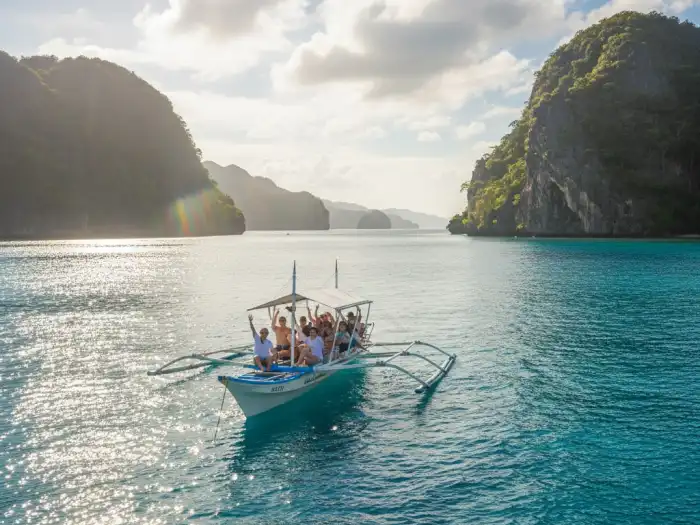
🌤️ Best Time to Visit El Nido (Weather, Season, and Crowd Tips)
Timing is everything when it comes to El Nido island hopping. The water might look postcard-perfect all year round, but weather and crowd levels can totally change your experience.
☀️ Dry Season (November to May) – Best Time to Visit
This is when El Nido truly shines. The skies are clear, the sea is calm, and every lagoon glows in that unreal shade of blue. Peak months are December to April, when boats can safely visit all destinations – even the far-off ones like Secret Beach.
Expect more tourists during Holy Week, Christmas, and long weekends, but it’s worth it. The vibe in town feels alive – everyone’s sunburned, smiling, and swapping stories over beer and grilled seafood by the beach.
🌧️ Rainy Season (June to October) – Cheaper but Riskier
If you’re after tipid travel, this is your window. Hotel rates drop by 30–40%, and you’ll have beaches mostly to yourself. But be warned – island-hopping tours can get cancelled if the Coast Guard flags rough seas or strong winds. It’s hit or miss, so plan for flexibility.
| Month Range | Weather Condition | Travel Notes |
|---|---|---|
| November – February | Cool and sunny | Ideal season; book early |
| March – May | Hot and dry | Peak crowds, great sea visibility |
| June – September | Rainy, choppy seas | Tour cancellations likely |
| October | Transition month | Mixed weather, fewer tourists |
🌴 Traveler’s Move
Book your flights around the early dry months (Nov–Feb) – perfect balance of good weather and lighter crowds. If you’re set on going during rainy season, stay at least 3–4 days in El Nido so you can reschedule if a tour gets cancelled.
And no matter when you go – bring patience. Boats don’t follow exact schedules here; tides and wind decide the day. That’s part of the charm, really.
🚐 How to Get to El Nido and Where to Stay
Getting to El Nido, Palawan takes a bit of effort – but once you see those lagoons, every hour on the road (or in the air) feels worth it.
✈️ How to Get to El Nido
| Route | Travel Time | Details |
|---|---|---|
| Direct Flight (Manila → El Nido Airport) | 1 hour | Operated by AirSWIFT, lands 10 mins from town; most convenient but pricey |
| Via Puerto Princesa (Manila → Puerto → El Nido) | 1 hr flight + 5–6 hr van/bus | Common route; vans available every hour (₱700–₱800) |
| Via Coron (Ferry) | 4–5 hours | For those exploring both Coron and El Nido; scenic but limited trips |
If you’re not in a rush, the Puerto Princesa route is the best balance – cheaper and lets you enjoy the countryside views (and maybe a quick stop for chaolong or tamilok along the way).
🏠 Where to Stay in El Nido
El Nido has something for every kind of traveler – from budget backpackers to honeymoon dreamers. Most stays are clustered in El Nido town, Corong-Corong, and Lio Beach.
| Area | Best For | Average Rate / Night (₱) | Vibe |
|---|---|---|---|
| El Nido Town Proper | Budget travelers | 800–1,500 | Near restaurants, bars, and pier |
| Corong-Corong Beach | Sunset chasers | 1,500–3,000 | Quieter, with beachfront stays |
| Lio Beach | Families & couples | 3,000–7,000 | Upscale, eco-luxury resort area |
| Nacpan Beach | Off-grid beach lovers | 2,000–5,000 | 45 mins from town, wide open beach |
🏝️ Local Hack
If you want the best of both worlds, stay in Corong-Corong. It’s just 5 minutes from town but way more peaceful, with front-row seats to fiery sunsets. Plus, most van transfers can drop you right at your accommodation – no trike haggling needed.
🌙 Traveler’s Move
Avoid staying too close to the main pier – it gets noisy in the mornings when tours start boarding. And don’t worry about “beachfront” hype; most tours pick up guests directly from their hotels anyway.
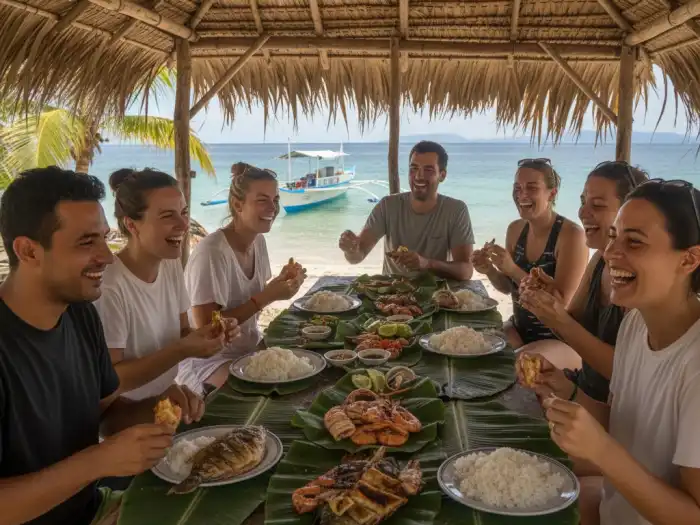
💸 Budget Breakdown and Travel Tips for El Nido Island Hopping
Let’s be real – El Nido looks expensive, but if you plan it right, it doesn’t have to drain your wallet. You can do the full island-hopping experience, eat well, and still come home with a few pesos left for pasalubong.
🧾 Estimated Budget for 3D2N Trip (Per Person)
| Expense | Estimated Cost (₱) | Notes |
|---|---|---|
| Manila → Puerto Princesa Flight (RT) | 2,500–4,000 | Watch out for seat sales |
| Van Transfer (RT) | 1,400–1,600 | Book directly at the terminal or online |
| Accommodation (2 nights) | 1,600–3,000 | Budget inn or beachfront lodge |
| Island Hopping Tour (A or C) | 1,200–1,600 | Includes lunch and snorkel gear |
| Eco-Tourism Fee | 200 | Valid for all tours for 10 days |
| Food & Drinks | 700–1,000 | Local eateries and beach bars |
| Miscellaneous / Tips | 300–500 | Souvenirs or kayak rentals |
| Total Estimate | ₱7,000–₱11,000 | Depending on travel style |
If you’re traveling as a group, share private tours and accommodations – the savings add up fast.
🧭 Travel Tips for First-Timers
-
Bring cash. ATMs in El Nido run out fast, and not all places accept GCash or cards.
-
Respect marine life. Don’t step on corals or chase fish – they’re not props.
-
Keep the town clean. El Nido is part of a protected area – even littering can get you fined.
-
Charge everything. Power outages still happen occasionally, especially during rainy months.
-
Tip your boat crew. They’ll keep you safe, serve you lunch, and even help you take perfect photos.
🌞 Local Hack
If you’re on a tight schedule, do Tour A and C on back-to-back days, then spend your last day chilling at Nacpan Beach or Lio Beach before heading back. The mix of adventure and downtime hits just right.
❓ FAQs About El Nido Island Hopping
-
What are the El Nido island-hopping tours?
El Nido offers four main island-hopping routes – Tour A, B, C, and D – each covering different beaches and lagoons in Bacuit Bay. Tour A and C are the most popular for first-timers. -
Which is better, El Nido Tour A or Tour C?
Both are must-tries. Tour A highlights lagoons and calm beaches; Tour C gives you adventure and secret spots. Do both if you can – they perfectly complement each other. -
How much does El Nido island hopping cost in 2025?
Standard tour prices range from ₱1,000 to ₱1,600 per person, including lunch, snorkeling gear, and guide fees. The ₱200 eco-tourism fee is paid once and valid for 10 days. -
Can I do El Nido island hopping on my own?
Nope. All tours are regulated and require accredited boats and guides for safety. DIY hopping isn’t allowed to protect marine zones and local livelihoods. -
When is the best time for island hopping in El Nido?
The dry months (November to May) offer the clearest water and calm seas. Rainy months may cause cancellations due to strong winds or rough conditions. -
What should I bring for El Nido island hopping?
Pack a dry bag, reef-safe sunscreen, towel, aqua shoes, and extra clothes. Don’t forget cash for kayak rentals and tips. -
How long does an El Nido island hopping tour last?
Tours usually run from 9 AM to 4 PM, with four to five island stops and a lunch break on the beach. Private tours can adjust schedules freely. -
Is it safe to go island hopping during the rainy season?
It’s generally safe when the Coast Guard allows it, but some destinations may close due to waves. Always check local advisories before booking. -
Where should I stay in El Nido for island hopping?
Stay near El Nido Town for easy pier access, or Corong-Corong Beach for quieter sunsets and hotel pick-ups directly from shore. -
What else can I do in El Nido aside from island hopping?
Try Nacpan Beach, Lio Beach, or Taraw Cliff viewpoint. You can also visit waterfalls, do inland motorbike tours, or just chill at cafés with a sunset beer.
🌞 The Kind of Beauty That Stays With You
When your boat drifts back to shore and the sun starts dipping behind the limestone cliffs, you’ll realize something – El Nido doesn’t just show you beauty; it reminds you of it. Of what it feels like to be small again, amazed again, alive again.
Sure, your arms will ache from paddling, your hair will be sticky from salt, and your skin two shades darker than yesterday. But you’ll also carry that quiet moment – when the water turned glass-clear, when laughter echoed across the waves, when you thought, “Sana hindi na matapos ‘to.”
That’s the thing about El Nido island hopping. It’s not just a checklist of lagoons and beaches. It’s the sound of the boat engine slowing down before a hidden cove, the first splash of cold water on your feet, the friendly “tara na!” from your boatman as he points to paradise.
And long after you’ve rinsed the salt from your skin, you’ll still feel it – that pull to go back. Because some places don’t just end when the trip does. They stay. Like sand in your bag. Like salt on your lips. Like a memory that hums, softly, “See you again.”
🧭 References
-
Tripiwi – El Nido Island Hopping Tours A, B, C & D – Which One to Choose?
-
JourneyEra – El Nido Island Hopping A, B, C or D: Which Tour to Choose?
-
PhilippineTravels – El Nido Travel Guide 2025: Everything You Need to Know Before…
-
The World Trippers – Island Hopping in El Nido, ABCD Tour
-
ElNidoParadise.com – El Nido Tours A, B, C, D – Island Hopping Tours in El Nido



